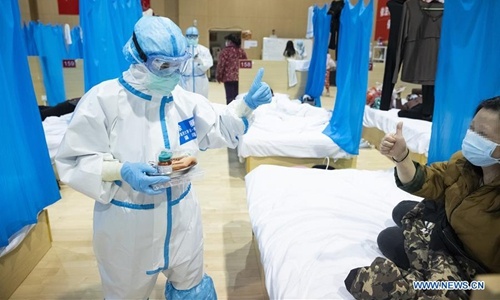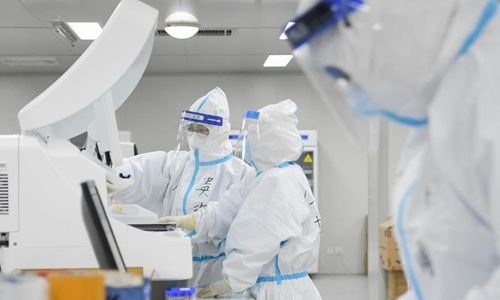
(Photo:Xinhua)
A notice from Northern China's Hebei Province says any persons from abroad confirmed with COVID-19 infection if lies about their health condition will have to fund all expenses associated with treatment by themselves, triggering many to calculate how much the epidemic would cost the Chinese government as confirmed cases in China are treated free of charge.
In Beijing, those who have not signed up to basic medical insurance when they return from abroad but were diagnosed as confirmed or suspected cases in China, will shoulder their own medical expenses, officials said on Saturday in a press conference.
Contrary to the US and other nations, individuals in China don't have to pay for expenses if they are confirmed or suspected cases with COVID-19.
According to policies outlined by the central government, for confirmed cases, after expenses are covered by medical insurance, the central financial subsidy will cover the part of the cost supposed to be paid by patients themselves. For suspected cases, their medical expenses will also be covered by regional finances and the central government will provide subsidies accordingly.
Medical bills for each patient vary in accordance with their symptoms. Some patients in the early stages are usually given antibacterial and anti-inflammatory drugs and if they have trouble breathing, hormone therapy is used.
Nucleic acid tests are free of charge, in addition to CT scans and blood routine examinations costing about 500 yuan. A patient with light symptoms may cost an average of 10,000 yuan in hospital, some confirmed patients from Wuhan told the Global Times.
An inpatient in Shenzhen may potentially spend about 12,000 yuan for an average of 11 days in hospital, according to a report based on 105 inpatients by accountant Li Yiping from the Shenzhen Third People's Hospital in February.
For those who stay in Fangcang makeshift hospitals in Wuhan, patients don't pay for their medical bills at all since tests, medicines, other medical treatments and daily meals are all covered by the government, a source close to the matter said.
Excluding Hubei, the average length of hospitalization nationwide is about 9 days and the number in Hubei Province is 20 days which had a large amount of severe patients, officials from National Health Commission said.
More than 80 percent of patients are mild cases, the virus causes severe disease in about 14 percent of cases, including pneumonia and shortness of breath; about 5 percent of patients will become critical with symptoms of respiratory failure and only 2 percent of those cases are fatal, the WHO had said.

(Photo:Xinhua)
For severe patients, the expenses will be much higher. Severe patients may need to use a ventilator in an ICU and sometimes they will need an infusion of gamma globulin to enhance immunity. Some extremely severe patients with respiratory failure will have to use extracorporeal membrane oxygenation (ECMO) systems.
The minimum cost of staying at an ICU is about 3,000 yuan each day and once the ECMO is activated it would generate bills of more than 60,000 yuan to 100,000 yuan per day. The costs for some patients would reach from 300,000 yuan to 400,000 yuan in total ($57,076) before they fully recover and be allowed to leave hospital, doctors from Shanghai revealed to the Global Times on Saturday on the condition of anonymity.
To fight against the epidemic, Chinese finance departments on all levels have allocated 108.75 billion yuan for epidemic prevention and control as of March 2, the Ministry of Finance said. But no official number was mentioned on expenses regarding how much of that would be spent on patients.
"It appears now that medical expenses are adequate, and the people will not delay treatment because of medical expenses," Fu Jinling, Director of the Department of Social Security from the Ministry of Finance said in a press conference on March 3.
The epidemic may not certainly cause a capital shortage in government finances as the fiscal regulation system is flexible, but the government may need to increase efficiency regarding use of fiscal resources to relieve the burden since the epidemic came at a time when economic growth is slowing down, Cui Jun, a professor at the Renmin University of China, told the Global Times on Saturday.
To make up for a potential gap, the government can reduce expenditures on administrative management, transportation and reception accordingly and raise the efficiency of public expenditure, Cui suggested, adding the government can also borrow more by releasing special bonds and encouraging welfare lotteries.
Hospitals are the main battlefield for viral prevention and control. To reduce financial pressure, many cities and provinces including Beijing, Shanghai, Shandong and Guangdong have prepaid funds to local medical institutions in face of the epidemic.
Take Hubei Province, which has been most severely affected by the epidemic, as an example. On January 25, Hubei Province had already allocated 1.03 billion yuan in medical insurance funds, of which Wuhan had allocated 702 million yuan.
The Beijing Medical Security Bureau paid an advance payment of 4.2 billion yuan in February to nearly 600 large hospitals in the city to ensure that patients will receive timely treatment in designated medical institutions.
Different scenario
Likewise, the South Korean government also offers free treatment to confirmed, suspected and observed cases. Patients in Japan, who test positive for COVID-19 will receive free medical treatment in hospitals. While medical expenses for patients of COVID-19 are a totally different scenario in the US.
In the US, tests for coronavirus are estimated at about $1300 each. Other medical treatment costs such as fees for doctors, hospital stays and medication will be vary depending on patients' personal health insurance, which may have thousands of dollars difference between people, a report by the CNBC concluded.
A Miami resident who received suspected coronavirus treatment in a hospital had a medical bill of $3500 and after insurance he still had to pay $1400, reports said.
Stories like this may occur everywhere in the US as people could be burdened with a large amount of medical bills even with insurance cover. The fear of medical expenses may trigger many to give up treatment potentially seeing the US outbreak spiral out of control, observers said.
The medical system in Italy has always been praised throughout the world, where citizens enjoy publicly funded medical care throughout their lives. But due to the lack of awareness from the Italian government, its medical system is severely burdened by such large amounts of confirmed cases of COVID19, where 17,660 cases were confirmed as of press time.


